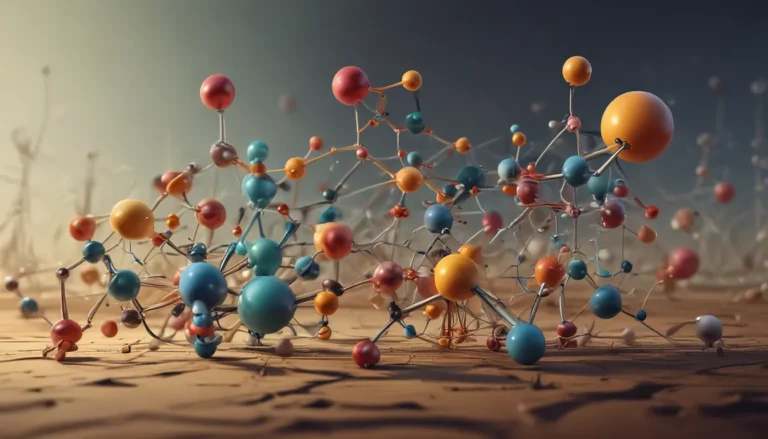A Note About Images: The images used in our articles are for illustration purposes only and may not exactly match the content. They are meant to engage readers, but the text should be relied upon for accurate information.
Chemistry is a complex and intricate field that delves into the very essence of matter and its interactions. One crucial concept that underpins the understanding of chemical compounds is coordination numbers. These numbers reveal the arrangement of atoms or ions around a central atom in a complex or coordination compound. By unraveling the mysteries of coordination numbers, chemists can predict the behavior, stability, and reactivity of these compounds, opening up a world of scientific possibilities.
In this comprehensive guide, we will uncover 17 extraordinary facts about coordination numbers that will deepen your knowledge and appreciation for this fundamental concept in chemistry. From the historical origins of coordination theory to the practical applications in industries like pharmaceuticals and electronics, we will journey through the intriguing world of coordination numbers and explore the remarkable aspects that make them a vital piece of the chemical puzzle.
So, get ready to embark on a fascinating journey as we unravel the secrets of coordination numbers and their impact on the world of chemistry.
Understanding Coordination Numbers: Key Takeaways
- Coordination numbers determine the shape and stability of chemical compounds, influencing their color, magnetic properties, and applications in various industries.
- Understanding coordination numbers helps scientists predict the behavior of compounds, from enzyme reactions in biological systems to catalytic efficiency in industrial processes.
Delving into the Definition and Importance of Coordination Numbers
The coordination number refers to the number of atoms or ions that surround a central atom in a chemical compound. This fundamental concept helps determine the geometric shape and stability of the compound, offering valuable insights into its properties and behavior. Understanding coordination numbers is essential in the field of chemistry as it allows scientists to predict the reactivity, optical properties, and overall behavior of compounds, paving the way for innovative research and discoveries.
The Varied Nature of Coordination Numbers
Coordination numbers can vary widely depending on the nature of the compound, ranging from 2 for a linear arrangement to 12 for a complex three-dimensional structure. This variability in coordination numbers underscores the diverse possibilities and complexities that exist within chemical compounds, offering a rich tapestry of structures and properties to explore and understand.
Unveiling the Secrets of Bonding Through Coordination Numbers
The coordination number plays a crucial role in indicating the type of bonding present in a compound. For example, a coordination number of 6 suggests a compound is likely to have octahedral geometry, indicating the presence of strong covalent bonds. By examining coordination numbers, scientists can gain valuable insights into the bonding interactions within a compound, shedding light on its structural and chemical properties.
Crystal Structures and the Significance of Coordination Numbers
In crystal structures, coordination numbers are particularly important as they determine the overall arrangement of atoms or ions in the crystal lattice. The coordination number of a central atom influences the symmetry and stability of the crystal structure, providing a foundation for understanding the unique properties exhibited by crystalline materials.
The Role of Ligands in Coordination Chemistry
Ligands are molecules or ions that bind to the central atom, forming coordination complexes. The coordination number dictates the maximum number of ligands that can bind to the central atom, influencing the overall structure and properties of the complex. By exploring the interactions between ligands and central atoms, scientists can unravel the intricacies of coordination chemistry and its applications in various fields.
Transition Metals and the Diversity of Coordination Numbers
Transition metals are known for exhibiting a variety of coordination numbers, allowing them to form complex compounds with diverse properties and applications. The flexibility of transition metals in accommodating different coordination environments highlights their importance in catalysis, materials science, and other industrial processes, showcasing the versatility and significance of coordination numbers in chemical research.
Exploring the Impact of Coordination Numbers on Magnetic Properties and Color
The coordination number of a compound can influence its magnetic properties and color, providing valuable insights into its electronic structure and behavior. Transition metal complexes with specific coordination numbers may exhibit paramagnetism or ferromagnetism, showcasing the intricate relationship between coordination numbers and physical properties. Additionally, coordination numbers can impact the color of a compound, with different coordination environments leading to a diverse range of colors due to electronic transitions.
Application of Coordination Numbers in Biochemical Processes and Catalysis
In biological systems, coordination numbers play a crucial role in enzyme reactions, electron transfer processes, and metal ion coordination in proteins and DNA. The understanding of coordination numbers is vital in elucidating the mechanisms of biochemical processes, highlighting the significance of this concept in biological research. Furthermore, coordination numbers can affect the efficiency of catalytic reactions, with the optimal coordination number for a catalyst depending on the specific reaction being catalyzed.
Industrial Applications and the Versatility of Coordination Numbers
Coordination compounds with specific coordination numbers find applications in various industries, including catalysis, materials science, pharmaceuticals, and electronics. The diverse range of properties exhibited by coordination complexes makes them invaluable in industrial processes, showcasing the practical implications of coordination numbers in real-world applications.
The Intricate Balance of Lewis Acids/Bases and Coordination Numbers
Coordination numbers are closely related to Lewis acids and bases, with coordination compounds involving the interaction between electron pair acceptors (Lewis acids) and electron pair donors (Lewis bases). The coordination of ligands to a central metal ion is governed by the principles of Lewis acid-base interactions, providing a foundation for understanding the stability and structure of coordination complexes.
Unlocking the Mysteries of Coordination Polymers and Coordination Chemistry
Coordination polymers are materials composed of repeated coordination units, with the coordination number of the building blocks determining the structure and properties of the resulting polymer. Coordination chemistry, the study of compounds containing coordination complexes, relies on the fundamental concept of coordination numbers to explore the diverse structures and behaviors exhibited by these compounds. By delving into the realm of coordination polymers and coordination chemistry, scientists can uncover new insights into the nature of chemical bonding and complex structures.
Advancing Scientific Knowledge Through Coordination Numbers
The study of coordination numbers is a fascinating aspect of chemistry that continues to contribute to our understanding of bonding, structure, and the behavior of various compounds. By delving into the intricacies of coordination numbers, scientists can expand their scientific horizons and unlock new realms of knowledge and discovery. From designing novel catalysts to studying the behavior of transition metals, coordination numbers offer a gateway to exploring the multifaceted world of chemical compounds and their properties.
Conclusion: Embracing the Significance of Coordination Numbers
In conclusion, coordination number is a fundamental concept in chemistry that plays a crucial role in understanding the structure and properties of various compounds. Through this comprehensive guide, we have explored 17 extraordinary facts about coordination numbers, shedding light on their significance in coordination complexes and chemical research. From their definition as the number of atoms or ions surrounding a central atom to their influence on stability, geometry, and magnetic properties, coordination numbers serve as a cornerstone in the study of chemical bonding and reactivity.
By unraveling the secrets of coordination numbers, scientists can pave the way for innovative research, technological advancements, and industrial applications, showcasing the broad impact of this concept on the field of chemistry. Whether you’re a chemistry enthusiast or a curious learner, delving into the world of coordination numbers offers a rich tapestry of knowledge and insights to explore, providing a deeper understanding of the fascinating realm of chemical compounds and their behavior.
FAQs: Unraveling Common Questions About Coordination Numbers
- What is coordination number?
-
Coordination number refers to the number of atoms or ions surrounding a central atom in a coordination complex or molecule.
-
How is coordination number determined?
-
Coordination number is determined by counting the number of bonds formed between the central atom and the ligands attached to it.
-
What is the significance of coordination number?
-
Coordination number plays a crucial role in determining the stability, geometry, and reactivity of coordination complexes. It helps in understanding chemical bonding and the behavior of transition metals in various industrial and biological processes.
-
Are there different types of coordination numbers?
-
Yes, there are different types of coordination numbers such as 2 (linear), 4 (tetrahedral or square planar), 6 (octahedral), and even higher numbers for more complex structures.
-
How does coordination number affect the properties of a complex?
- The coordination number directly affects the shape, stability, and magnetic properties of a complex. It also influences the type of ligands that can bind to the central atom.
Embark on a Journey of Discovery
Coordination numbers play a crucial role in chemistry, shaping the properties and behavior of chemical compounds. By exploring the intricate world of coordination numbers, we can unravel the mysteries of chemical bonding, structure, and reactivity, opening up new avenues for scientific exploration and innovation. Whether you’re a seasoned chemist or an aspiring scientist, the realm of coordination numbers offers a captivating journey of discovery and knowledge. So, embrace the challenges and opportunities presented by coordination numbers, and delve into the fascinating world of chemical compounds and their intricate dance of atoms and molecules.
Our Commitment to Quality and Authenticity
Our commitment to delivering trustworthy and engaging content is at the heart of what we do. Each fact on our site is contributed by real users like you, bringing a wealth of diverse insights and information. To ensure the highest standards of accuracy and reliability, our dedicated editors meticulously review each submission. This process guarantees that the facts we share are not only fascinating but also credible. Trust in our commitment to quality and authenticity as you explore and learn with us.






